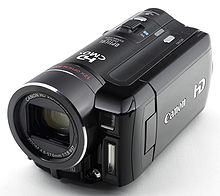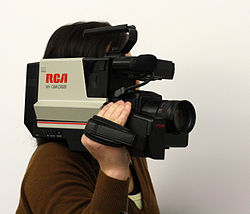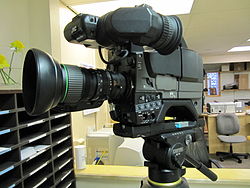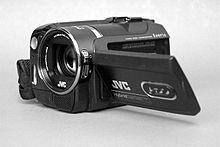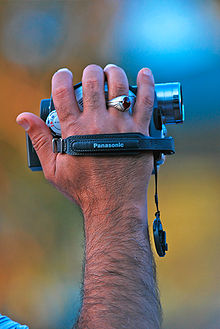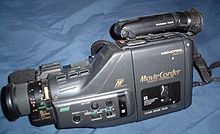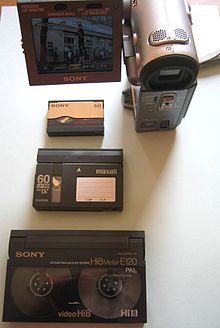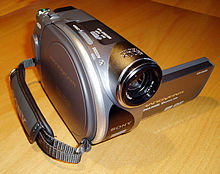- Camcorder
-
A camcorder (videocamera recorder) is an electronic device that combines a video camera and a video recorder into one unit.[1][2][3] Equipment manufacturers do not seem to have strict guidelines for the term usage. Marketing materials may present a video recording device as a camcorder, but the delivery package would identify content as video camera recorder.
In order to differentiate a camcorder from other devices that are capable of recording video, like mobile phones and digital compact cameras, a camcorder is generally identified as a portable, self-contained device having video capture and recording as its primary function.[4][5]
The earliest camcorders employed analog recording onto videotape. Tape-based camcorders use removable media in the form of video cassettes. Nowadays, digital recording has become the norm, with tape being gradually replaced with other storage media such as internal flash memory, hard drive, and SD card. As of January 2011, none of the new consumer-class camcorders announced at the 2011 International Consumer Electronics Show record on tape.[6]
Camcorders that do not use magnetic tape are often called tapeless camcorders, while camcorders that permit using more than one type of medium, like built-in hard disk drive and memory card, are sometimes called hybrid camcorders.
Contents
History
Video cameras originally designed for television broadcast were large and heavy, mounted on special pedestals, and wired to remote recorders located in separate rooms.
As technology advanced, out-of-studio video recording was made possible by means of compact video cameras and portable video recorders. The recording unit could be detached from the camera and carried to a shooting location. While the camera itself could be quite compact, the fact that a separate recorder had to be carried along made on-location shooting a two-man job.[8] Specialized Videocassette recorders were introduced by both JVC (VHS) and Sony (U-matic and Betamax) to be used for mobile work. The advent of the portable recorders helped to eliminate the phrase "film at eleven"—rather than wait for the lengthy process of film developing, recorded video could be shown during the 6 o'clock news.
In 1982 Sony released the Betacam system. A part of this system was a single camera-recorder unit, which eliminated the cable between camera and recorder and dramatically improved the freedom of a cameraman. Betacam used the same format 1/2" tape cassette as Betamax, but running much faster for higher quality and reliability. It quickly became the standard for both news-gathering and in-studio video editing.
The following year Sony released the first consumer camcorder—the Betamovie BMC-100P. It used a Betamax cassette and could not be held with one hand, so it was typically resting on a shoulder. In the same year JVC released the first camcorder based on VHS-C format.[8]
In 1985 Sony came up with its own compact video cassette format—Video8. Both VHS-C and Video8 had their benefits and drawbacks, and neither won the format war.
In the same year, Panasonic, RCA, and Hitachi began producing camcorders that recorded to full-sized VHS cassette and offered up to 3 hours of record time. These shoulder-mount camcorders found a niche with videophiles, industrial videographers, and college TV studios. Super VHS (S-VHS) full-sized camcorders were released in 1987 which exceeded the broadcast quality of the day and provided an inexpensive way to collect news segments or videographies. Sony matched this with the release of Hi8, an upgraded version of Video8.
One year later Sony introduced the first digital video format, D1. Video was recorded in uncompressed form and required enormous bandwidth for its time. In 1992 Ampex used D1 form-factor to create DCT, the first digital video format that utilized data compression. The compression utilized discrete cosine transform algorithm, which is used in most modern commercial digital video formats.
In 1995 Sony, JVC, Panasonic and other video camera manufacturers launched DV, which quickly became a de-facto standard for home video production, for independent filmmaking and for citizen journalism. In the same year Ikegami introduced Editcam - the first tapeless video recording system.
Panasonic launched DVCPRO HD in 2000, expanding the DV codec to support high definition. The format was intended for use in professional camcorders and used full-size DVCPRO cassettes. In 2003 Sony, JVC, Canon and Sharp introduced HDV, the first truly affordable high definition video format, which used inexpensive MiniDV cassettes.
In 2003 Sony pioneered XDCAM, the first tapeless video format, which uses Professional Disc as recording media. Panasonic followed next year, offering P2 solid state memory cards as recording medium for DVCPRO HD video.
In 2006 Panasonic and Sony introduced AVCHD as an inexpensive consumer-grade tapeless high definition video format. Presently AVCHD camcorders are manufactured by Sony, Panasonic, Canon, JVC and Hitachi.
In the following year Sony introduced XDCAM EX, which offers similar recording modes to XDCAM HD, but records on SxS memory cards.
With proliferation of file-based digital formats the relationship between recording media and recording format became weaker than ever: the same video can be recorded onto different media. With tapeless formats, recording media has become a storage device for digital files, signifying convergence of video and computer industries.
Overview
Camcorders contain 3 major components: lens, imager, and recorder. The lens gathers and focuses light on the imager. The imager (usually a CCD or CMOS sensor on modern camcorders; earlier examples often used vidicon tubes) converts incident light into an electrical signal. Finally, the recorder converts the electric signal into video and encodes it into a storable form. More commonly, the optics and imager are referred to as the camera section.
Lens
The lens is the first component in the light path. The camcorder's optics generally have one or more of the following adjustments:
- aperture or iris to regulate the exposure and to control depth of field;
- zoom to control the focal length and angle of view;
- shutter speed to regulate the exposure and to maintain desired motion portrayal;
- gain to amplify signal strength in low-light conditions;
- neutral density filter to regulate the exposure.
In consumer units, the above adjustments are often automatically controlled by the camcorder's electronics, but can be adjusted manually if desired. Professional units offer direct user control of all major optical functions.
Imager
The imager converts light into electric signal. The camera lens projects an image onto the imager surface, exposing the photosensitive array to light. The light exposure is converted into electrical charge. At the end of the timed exposure, the imager converts the accumulated charge into a continuous analog voltage at the imager's output terminals. After scan-out is complete, the photosites are reset to start the exposure-process for the next video frame.
Recorder
The recorder is responsible for writing the video-signal onto a recording medium (such as magnetic videotape.) The record function involves many signal-processing steps, and historically, the recording-process introduced some distortion and noise into the stored video, such that playback of the stored-signal may not retain the same characteristics/detail as the live video feed.
All but the most primitive camcorders imaginable also need to have a recorder-controlling section which allows the user to control the camcorder, switch the recorder into playback mode for reviewing the recorded footage and an image control section which controls exposure, focus and white-balance.
The image recorded need not be limited to what appeared in the viewfinder. For documentation of events, such as used by police, the field of view overlays such things as the time and date of the recording along the top and bottom of the image. Such things as the police car or constable to which the recorder has been allotted may also appear; also the speed of the car at the time of recording. Compass direction at time of recording and geographical coordinates may also be possible. These are not kept to world-standard fields; "month/day/year" may be seen, as well as "day/month/year", besides the ISO standard "year-month-day".
Consumer camcorders
Analog vs. digital
Camcorders are often classified by their storage device: VHS, VHS-C, Betamax, Video8 are examples of 20th century videotape-based camcorders which record video in analog form. Newer digital video camcorder formats include Digital8, MiniDV, DVD, Hard disk drive direct to disk recording and solid-state semiconductor Flash memory memory. While all these formats record video in digital form, currently formats like Digital8, MiniDV and DVD have been losing favor, and are no longer used in the most recent consumer camcorders.
In older analog camcorders, the imaging device was based on vacuum tube technology where the charge on a light sensitive target was in direct proportion to the amount of light striking it. A popular example of such an imaging tube was the Vidicon. Newer analog and all digital camcorders use a solid state Charge Coupled Device (CCD) imaging device, or more recently a CMOS imager. Both of these latter devices use photodiodes that pass a current proportional to the light striking them (i.e. they are analog detectors), but that current is then digitised before being electronically 'scanned' before being fed to the imager's output. The principal difference in the latter two devices is in the manner in which that 'scanning' is accomplished. In the CCD, the diodes are all sampled simultaneously, and the scanning then achieved by passing the digitised data from one register to the next (the Charge Coupled element). In the CMOS device the diodes are sampled directly by the scanning logic.
The take up of digital video storage improved quality. MiniDV storage allows full resolution video (720x576 for PAL, 720x480 for NTSC), unlike previous analogue consumer video standards. Digital video does not experience colour bleeding, jitter, or fade, although some users still prefer the analog nature of Hi8 and Super VHS-C, since neither of these produce the "background blur" or "mosquito noise" of digital video compression. In many cases, a high-quality analog recording shows more detail (such as rough textures on a wall) than a compressed digital recording (which would show the same wall as flat and featureless).
Unlike analog video formats, the digital video formats do not suffer generation loss during dubbing, but can be more prone to complete loss. Theoretically digital information can be stored indefinitely with zero deterioration on a digital storage device (such as a hard drive), however since some digital formats (like MiniDV) often squeeze tracks only ~10 micrometers apart (versus 19 to 58 μm for VHS), a digital recording is more vulnerable to wrinkles or stretches in the tape that could permanently erase several scenes worth of digital data, but the additions tracking and error correction code on the tape will generally compensate for most defects. On analog media similar damage barely registers as "noise" in the video, still leaving a deteriorated but watchable video. The only limitation is that this video has to be played on a completely analogue viewing system, otherwise the tape will not display any video due to the damage and sync problems. Even digital recordings on DVD are known to suffer from DVD rot that permanently erase huge chunks of data. Thus the one advantage analog seems to have in this respect is that an analog recording may be "usable" even after the media it is stored on has suffered severe deterioration whereas it has been noticed[9] that even slight media degradation in digital recordings may cause them to suffer from an "all or nothing" failure, i.e. the digital recording will end up being totally un-playable without very expensive restoration work.
Modern recording media
For more information, see tapeless camcorder.
While some older digital camcorders record video on Microdrives and size-reduced DVD-RAM or DVD-Rs, as of 2011 most recent camcorders record video on flash memory devices and small hard disks, using MPEG-1, MPEG-2 or MPEG-4 formats. However, because these codecs use inter-frame compression, frame-specific-editing requires frame regeneration, which incurs additional processing and can cause loss of picture information. (In professional usage, it is common to use a codec that will store every frame individually. This provides easier and faster frame-specific editing of scenes.)
Other digital consumer camcorders record in DV or HDV format on tape and transfer content over FireWire (some also use USB 2.0) to a computer, where the huge files (for DV, 1GB for 4 to 4.6 minutes in PAL/NTSC resolutions) can be edited, converted, and (with many camcorders) also recorded back to tape. The transfer is done in real time, so the complete transfer of a 60 minute tape needs one hour to transfer and about 13GB disk space for the raw footage only—excluding any space needed for render files, and other media. Time spent in post-production (editing) to select and cut the best shots varies from instantaneous "magic" movies to hours of tedious selection, arrangement and rendering.
Consumer market
As the mass consumer market favors ease of use, portability, and price, most of the consumer-grade camcorders sold today emphasize handling and automation features over raw audio/video performance. Thus, the majority of devices capable of functioning as camcorders are camera phones or compact digital cameras, for which video is only a feature or a secondary capability.
Even for separate devices intended primarily for motion video, this segment has followed an evolutionary path driven by relentless miniaturization and cost reduction, made possible by progress in design and manufacturing. Miniaturization conflicts with the imager's ability to gather light, and designers have delicately balanced improvements in sensor sensitivity with sensor size reduction, shrinking the overall camera imager & optics, while maintaining reasonably noise-free video in broad daylight. Indoor or dim light shooting is generally unacceptably noisy, and in such conditions, artificial lighting is highly recommended. Mechanical controls cannot scale below a certain size, and manual camera operation has given way to camera-controlled automation for every shooting parameter (focus, aperture, shutter speed, white balance, etc.) The few models that do retain manual override frequently require the user to navigate a cumbersome menu interface. Outputs include USB 2.0, Composite and S-Video, and IEEE 1394/Firewire (for MiniDV models). On the plus side, today's camcorders are affordable to a wider segment of the consumer market, and available in a wider variety of form factors and functionality, from the classic camcorder shape, to small flip-cameras, to video-capable camera-phones and "digicams."
At the high-end of the consumer market, there is a greater emphasis on user control and advanced shooting modes. Feature-wise, there is some overlap between the high-end consumer and "prosumer" markets. More expensive consumer camcorders generally offer manual exposure control, HDMI output and external audio input, progressive-scan framerates (24fps, 25fps, 30fps), and better lenses than basic models. In order to maximize low-light capability, color reproduction, and frame resolution, a few manufacturers offer multi-CCD/CMOS camcorders, which mimic the 3-element imager design used in professional equipment. Field tests have demonstrated most consumer camcorders (regardless of price), to produce noisy video in low light.
Before the 21st century, video editing was a difficult task requiring a minimum of two recorders and possibly a desktop video workstation to control them. Now, the typical home personal computer can hold several hours of standard-definition video, and is fast enough to edit footage without additional upgrades. Most consumer camcorders are sold with basic video editing software, so users can easily create their own DVDs, or share their edited footage online.
In the first world market, nearly all camcorders sold today are digital. Tape-based (MiniDV/HDV) camcorders are no longer popular, since tapeless models (SD card & internal drive) cost almost the same, but offer much greater convenience. For example, video captured on SD card can be transferred to a computer much faster than from digital tape. Hard disk camcorders feature the longest continuous recording time, though the durability of the hard drive is a concern for harsh and high-altitude environments. As of January 2011, none of the new consumer-class camcorders announced at the 2011 International Consumer Electronics Show record on tape.[6] However, in some parts of the world, newly-manufactured tape camcorders might still be available due to the lower purchasing power or greater price sensitivity of the consumers in these areas.
Other devices with video-capture capability
Video-capture capability is not confined to camcorders. Cellphones, digital single lens reflex and compact digicams, laptops, and personal media players frequently offer some form of video-capture capability. In general, these multipurpose-devices offer less functionality for video-capture, than a traditional camcorder. The absence of manual adjustments, external-audio input, and even basic usability functions (such as autofocus and lens-zoom) are common limitations. Few can capture to standard TV-video formats (480p60, 720p60, 1080i30), and instead record in either non-TV resolutions (320x240, 640x480, etc.) or slower frame-rates (15fps, 30fps.)
When used in the role of a camcorder, a multipurpose-device tends to offer inferior handling and audio/video performance, which limits its usability for extended and/or adverse shooting situations. However, much as camera-equipped cellphones are now ubiquitous, video-equipped electronic devices will likely become commonplace, replacing the market for low-end camcorders.
The past few years have seen the introduction of DSLR cameras with high-definition video. Although they still suffer from the typical handling and usability deficiencies of other multipurpose-devices, HDSLR video offers two videographic features unavailable on consumer camcorders: shallow depth-of-field and interchangeable lenses. Professional video cameras possessing these capabilities are currently more expensive than even the most expensive video-capable DSLR. In video applications where the DSLR's operational deficiencies can be mitigated by meticulous planning of the each shooting location, a growing number of video productions are employing DSLRs, such as the Canon 5D Mark II, to fulfill the desire for depth-of-field and optical-perspective control. Whether in a studio or on-location setup, the scene's environmental factors and camera placement are known beforehand, allowing the director of photography to determine the proper camera/lens setup and apply any necessary environmental adjustments, such as lighting.
A recent development to combine the feature-sets of full-feature still-camera and camcorder in a single unit, is the combo-camera. The Sanyo Xacti HD1 was the first such combo unit, combining the features of a 5.1 megapixel still-camera with a 720p video recorder. Overall, the product was a step forward in terms of a single-device's combined level of handling and usability . The combo camera's concept has caught on with competing manufacturers; Canon and Sony have introduced camcorders with still-photo performance approaching a traditional digicam, while Panasonic has introduced a DSLR-body with video features approaching a traditional camcorder. Hitachi have introduced the DZHV 584E/EW which has 1080p resolution. This model comes with a 3" pop-up touch screen, housed in a slim line-case and about the size of a mobile phone.
Interchangeable lens camcorder
As reverse of DSLR cameras with high-definition video, in 2011 at least there are 2 Interchangeable lens camcorders which can capture Full HD video with full control of camcorder, Panasonic AG-AF100 and Sony NEX-VG10 both with big sensor, not as usual as non-professional camcorders. The DSLR lenses can be used with adapter for versatilities.[10]
Camcorder with built-in projector
In 2011 Sony released the HDR-PJ10/30/50 HD camcorders. These are the first camcorders in the world to incorporate a small projector located on the side of the unit. This feature allows the user to show their video to a group of viewers without the need to connect up to a television or a full-size projector or even to upload onto a computer. Such a feature would have been unimaginable only a generation ago. The specification varies between each model, the HDR-PJ10 is the base model with 16GB internal memory. The HDR-PJ30 has double the capacity (32GB), an additional light to aid in darkness and the ability to shoot a 25p image making the video appear as if it was shot on film. The HDR-PJ50 is the top of the range model with a 220GB hard disk drive as well as the light to aid in darkness. [11] Similar products are available from ViewSonic [12] and 3M.
3D Camcorder
In 2011 Panasonic released the world's first camcorder to be capable of shooting in 3D, the HDC-SDT750. It is a regular 2D camcorder that can shoot in full HD while 3D is achieved by the detachable conversion lens. Sony subsequently released its own 3D camcorder, the HDR-TD10. Unlike the Panasonic, the Sony HDR-TD10 has the 3D lens built in but it can still shoot a normal 2D video. The down side to this is that it results in a rather ugly design and a high price tag (£1,005.70 for the Sony vs. £686 for the Panasonic on Amazon). Panasonic have also released normal 2D camcorders with optional 3D recording with the conversion lens being an optional extra. The HDC-SD90, HDC-SD900, HDC-TM900 and HDC-HS900 are marketed as '3D ready' being affordable regular 2D camcorders with the option to add the 3D capability at a later date. Sony and some other manufacturers have even marketed 3D pocket camcorders, an example being the Sony MHS-FS3. Sony are releasing the DEV-5 3D camcorder, however Sony markets it as digital recording binoculars due to the shape of the unit. The down side of this unusual camcorder is the hefty price tag, £2,605 on Sony's website, almost treble that of the Sony HDR-TD10. Currently only Panasonic and Sony manufacture 3D camcorders but it is unknown is to whether these will catch on, only time will tell.
Uses
Media
Camcorders have found use in nearly all corners of electronic media, from electronic news organizations to TV/current-affairs productions. In locations away from a distribution infrastructure, camcorders are invaluable for initial video acquisition. Subsequently, the video is transmitted electronically to a studio/production center for broadcast. Scheduled events such as official press conferences, where a video infrastructure is readily available or can be feasibly deployed in advance, are still covered by studio-type video cameras (tethered to "production trucks.")
Home video
For casual use, camcorders often cover weddings, birthdays, graduation ceremonies, children growing up, and other personal events. The rise of the consumer camcorder in the mid to late '80s led to the creation of shows such as the long-running America's Funniest Home Videos, where people could showcase homemade video footage.
Politics
Political protestors who have capitalized on the value of media coverage use camcorders to film things they believe to be unjust. Animal rights protesters who break into factory farms and animal testing labs use camcorders to film the conditions the animals are living in. Anti-hunting protesters film fox hunts. People expecting to witness political crimes use cameras for surveillance to collect evidence. Activist videos often appear on Indymedia.
The police use camcorders to film riots, protests and the crowds at sporting events. The film can be used to spot and pick out troublemakers, who can then be prosecuted in court. In countries such as the United States, the use of compact dashboard camcorders in police cars allows the police to retain a record of any activity that takes place in front of the car, such as interaction with a motorist stopped on the highway.
Entertainment and movies
Camcorders are often used in the production of low-budget TV shows where the production crew does not have access to more expensive equipment. There are even examples of movies shot entirely on consumer camcorder equipment (such as The Blair Witch Project and 28 Days Later). In addition, many academic filmmaking programs have switched from 16mm film to digital video, due to the vastly reduced expense and ease of editing of the digital medium as well as the increasing scarcity of film stock and equipment. Some camcorder manufacturers cater to this market, particularly Canon and Panasonic, who both support "24p" (24 frame/s, progressive scan; same frame rate as standard cinema film) video in some of their high-end models for easy film conversion.
Even high-budget cinema is done using camcorders in some cases; George Lucas used Sony CineAlta camcorders in two of his three Star Wars prequel movies. This process is referred to as digital cinematography.
Education, Teacher Evaluation and Teacher Preparation
Secondary Education and Higher Education in the developed world is increasingly integrating digital media and computing into the fabric of students learning experiences. Students often use camcorders to record video diaries, make short films, and develop a variety of multi-media projects across subject disciplines.
Meanwhile teacher evaluation increasingly involves teacher's classroom lessons being digitally recorded for review by school administrators and school district officials. This is especially common during the process of tenure-granting (or withholding), and in cases where teacher's continued tenure may be in question. Some feel the use of digital recording allows both school districts and teacher's unions an opportunity to more objectively and comprehensively review aspects of teacher performance in the classroom setting, whilst others, such as Alfie Kohn are far more skeptical.
Recently in many a top ranked School of Education, integration of student camcorder-created material as well as other digital technology has ingrained itself into the fabric of new teacher preparation courses. The University of Oxford Department of Education PGCE programme and NYU's Steinhardt School's Department of Teaching and Learning MAT programme provide two examples of this trend.
The USC Rossier School of Education takes this one step further, by insisting that all students purchase their own camcorder (or similar digital video recording devise) as a prerequisite to beginning their MAT education programmes, many of which are delivered entirely online. These programmes employ a modified version of Adobe Connect to deliver the entire taught component of the MAT@USC. MAT students in-class teaching is captured by camcorder, posted to USC's web portal, and then go through a process of evaluation by faculty in a similar manner to what they would use if they were physically present in class.
In this way the use of the camcorder has allowed USC to entirely de-centralize its teacher preparation away from Southern California to most American states, and several countries around the world; and this has greatly increased the number of teachers they are able to train at once. With significant teacher shortages looming in the USA, UK, Canada and Australia over the next few years, this is likely to be a model which other institutions seek to emulate.
Formats
The following list covers consumer equipment only. (For other formats see Videotape)
Analog
- Lo-Band: Approximately 3 megahertz bandwidth (250 lines EIA resolution or ~333x480 edge-to-edge)
-
- BCE (1954): First tape storage for video, manufactured by Bing Crosby Entertainment from Ampex equipment.
- BCE Coloer (1955): First color tape storage for video, manufactured by Bing Crosby Entertainment from Ampex equipment.
- Simplex (1955): Developed commercially by RCA and used to record several live broadcasts by NBC.
- Quadruplex (1955): Developed formally by Ampex, and this became the recording standard for the next 20 years.
- Vera (1955): An experimental recording standard developed by the BBC, but was never used or sold commercially.
- U-matic (1971): The initial tape used by Sony to record video.
- U-matic S (1974): A small sized version of U-matic used for portable recorders.
- Betamax (1975): Only used on very old Sony and Sanyo camcorders and portables; obsolete by the mid/late-80s in the consumer market.
- VHS (1976): Compatible with VHS standard VCRs, though VHS camcorders are no longer made.
- VHS-C (1982): Originally designed for portable VCRs, this standard was later adapted for use in compact consumer camcorders; identical in quality to VHS; cassettes play in standard VHS VCRs using an adapter. Still available in the low-end consumer market (JVC model GR-AXM18 is VHS-C; see page 19 of the owner's manual). Relatively short running time compared to other formats.
- Video8 (1985): Small-format tape developed by Sony to combat VHS-C's compact palm-sized design; equivalent to VHS or Betamax in picture quality, but not compatible. High quality audio as standard.
-
- Hi-Band: Approximately 5 megahertz bandwidth (420 lines EIA resolution or ~550x480 edge-to-edge)
-
- U-matic BVU (1982): Largely used in high-end consumer and professional equipment. The introduction of U-matic BVU spelled the end of 16mm film recordings.
- U-matic BVU-SP (1985): Largely used in high-end consumer and professional equipment. The introduction of U-matic BVU spelled the end of 16mm film recordings.
- S-VHS (1987): Largely used in medium-end consumer and prosumer equipment; rare among mainstream consumer equipment, and rendered obsolete by digital gear like DigiBetacam and DV.
- S-VHS-C (1987): An upgrade to provide near-laserdisc quality. Now limited to the low-end consumer market (example: JVC SXM38). As per VHS-C, relatively short running time compared to other formats.
- Hi8 (1988): Enhanced-quality Video8; roughly equivalent to Super VHS in picture quality, but not compatible. High quality audio as standard. Now limited to low-end consumer market (example: Sony TRV138)
-
Digital
-
-
- MiniDV (1995): Smaller version of the DV standard was released by Sony, which became the most widespread standard-definition digital camcorder technology for several years, and was the format which made capturing footage via the 4 pin DV socket to your computer easy for video editing.[13]
- DVD (1995): Uses either Mini DVD-R or DVD-RAM. This is a multi-manufacturer standard that uses 8 cm DVDs for 30 minutes of video. DVD-R can be played on consumer DVD players but cannot be added to or recorded over once finalized for viewing. DVD-RAM can be added to and/or recorded over, but cannot be played on many consumer DVD players, and costs a lot more than other types of DVD recordable media. The DVD-RW is another option allowing the user to re-record, but only records sequentially and must be finalized for viewing. The discs do cost more than the DVD-R format, which only records once. DVDs are also very vulnerable to scratches. DVD camcorders are generally not designed to connect to computers for editing purposes, though some high-end DVD units do record surround sound, a feature not standard with DV equipment.
- DV (1996): Sony debuted the DV format tape with DVCAM being professional and DVCPRO being a Panasonic variant.
- D-VHS (1998): JVC debuted the digital standard of VHS tape and which supported 1080p HD. Many units also supported IEEE1394 recording.
- Digital8 (1999): Uses Hi8 tapes (Sony is the only company currently producing D8 camcorders, though Hitachi once also did). Most, but not all models of Digital 8 cameras have the ability to read older Video8 and Hi8 analog format tapes. The format's technical specifications are of the same quality as MiniDV (both use the same DV codec), and although no professional-level Digital8 equipment exists, D8 has been used to make TV and movie productions (example: Hall of Mirrors).
- MICROMV (2001): Uses a matchbox-sized cassette. Sony was the only electronics manufacturer for this format, and editing software was proprietary to Sony and only available on Microsoft Windows; however, open source programmers did manage to create capture software for Linux [1]. The hardware is no longer in production, though tapes are still available through Sony.
- Blu-ray Disc (2003): Presently, Hitachi is the only manufacturer of Blu-ray Disc camcorders.
- HDV (2004): Records up to an hour of HDTV MPEG-2 signal roughly equal to broadcast quality HD on a standard MiniDV cassette.
- MPEG-2 codec based format, which records MPEG-2 program stream or MPEG-2 transport stream to various kinds of tapeless media (hard disks, solid-state memory, etc). Used both for standard definition (JVC, Panasonic) and high definition (JVC) recording.
- H.264, shorthand term for compressed video using the H.264 codec that is part of the MPEG-4 standard in an MPEG-4 file most often stored to tapeless media.
- AVCHD, a format that puts H.264 video into a transport stream file format. The video is compressed according to the MPEG-4 AVC (aka H.264) format, but the file format is not MPEG-4.
- Multiview Video Coding is an amendment to H.264/MPEG-4 AVC video compression standard for sequences captured simultaneously from multiple cameras using a single video stream. An MVC stream is backward compatible with H.264/AVC, which allows older devices and software to decode stereoscopic video streams, ignoring additional information for the second view. Multiview video contains a large amount of inter-view statistical dependencies therefore combined temporal and inter-view prediction is the key for efficient MVC encoding. A frame from a certain camera can be predicted not only from temporally related frames from the same camera, but also from the frames of neighboring cameras. These interdependencies can be used for efficient prediction.
-
Digital camcorders and operating systems
Since most manufacturers focus their support on Windows and Mac users, users of other operating systems often are unable to receive support for these devices. However, open source products such as Cinelerra and Kino (written for the Linux operating system) do allow full editing of some digital formats on alternative operating systems, and software to edit DV streams in particular is available on most platforms.
Handycam
Handycam is a Sony brand used to market its camcorder range. It was launched in 1985 as the name of the first Video8 camcorder, replacing Sony's previous line of Betamax-based models, and the name was intended to emphasize the "handy" palm size nature of the camera, made possible by the new miniaturized tape format. This was in marked contrast to the larger, shoulder mounted cameras available before the creation of Video8, and competing smaller formats such as VHS-C.
Sony has continued to produce Handycams [14] in a variety of guises ever since, developing the Video8 format to produce Hi8 (equivalent to S-VHS quality) and later Digital8, using the same basic format to record digital video. The Handycam label continues to be applied as recording formats evolve.
A commercial for the Sony Handycam was made in June 2005 in Europe with the song "I Love You, ONO" by Stereo Total.
Handycam models
- Handycam (Video8 (1985~2001))
- Hi8 Handycam (1989–2008)
- Digital8 Handycam (1998–2008)
- DV Handycam (1995~)
- HDV Handycam
- DVD-Handycam
- Hard disk drive|HDD Handycam
- Memory Stick Handycam (using Memory Stick Pro Duo. Up to 16GB)
- Sony Handycam NEX-VG10
See also
- 3CCD
- AVCHD
- CMOS
- Flip Video
- Firewire
- Charge-coupled device
- Dew warning
- PictBridge
- PXL-2000—A toy camcorder that used compact audio cassette to store video
- Pocket video camera
- SteadyShot
- USB streaming and USB port.
- VTR
- Professional video camera
References
- ^ "TheFreeDictionary.com: camcorder". http://www.thefreedictionary.com/camcorder. Retrieved 2009-08-05.
- ^ "Consumer Reports: camcorder buying guide". http://www.consumerreports.org/cro/electronics-computers/audio-video/camcorders/camcorder-buying-advice/camcorder-guide/camcorders-getting-started.htm. Retrieved 2009-08-05.
- ^ "Merriam-Webster dictionary: camcorder". http://www.merriam-webster.com/dictionary/camcorder. Retrieved 2009-08-05.
- ^ "Dictionary.com: camcorder". http://dictionary.reference.com/browse/camcorder. Retrieved 2009-08-05.
- ^ "Ebay.com: digital camcorders". http://popular.ebay.com/ns/Cameras-Photo/Digital-Camcorder.html. Retrieved 2009-08-05.
- ^ a b http://www.camcorderinfo.com/2011-CES-Camcorders.htm
- ^ "Britannica online encyclopedia: camcamcorder". http://www.britannica.com/EBchecked/topic/90727/camcorder. Retrieved 2008-08-05.
- ^ a b "Separate camera and recorder; First VHS-C camcorder". 2007-09-14. http://www.totalrewind.org/cameras/C_SFP3.htm. Retrieved 2007-09-14.
- ^ Video Tape Discussion - Videotape Life Expectancy
- ^ "Sony NEX-VG10: An HD Camcorder With DSLR Brains". August 13, 2011. http://www.pcworld.com/article/201036/sony_nexvg10_an_hd_camcorder_with_dslr_brains.html.
- ^ "Handycam HD camcorder with built in projector: Sony". November 1, 2011. http://www.sony.co.uk/hub/1237482618998.
- ^ Projector Central ViewSonic DVP5 Comcorder Projector
- ^ "Transfer Video from your Camcorder to Your PC". Transfer Video from your Camcorder to Your PC. New Wave TV. http://www.newwavetv.co.uk/2011/05/20/transfer-video-from-your-camcorder-to-your-pc-focus-on-sockets/. Retrieved 15 August 2011.
- ^ HandyCam
External links
Categories:- Camcorders
- 1983 introductions
- Consumer electronics
Wikimedia Foundation. 2010.

